Ralph Deutsch – Deutsch Research Laboratories |
Around this time my father’s parents moved from Winthrop to live near us. My father found them a nice apartment in Encino a few blocks from Ma’arev Temple. We would visit them at least weekly. They spent most of the time complaining about how things aren’t like they used to be or how some other relative of theirs was doing very well! My father was not completely fulfilled by the Allen organ experience. In addition to the lack of market penetration achieved by Allen, Rockwell failed to reward him personally as he had expected. Other inventors at Rockwell were evidently rewarded 10% of the market value for their inventions, but the Computer Organ did not have this result. My father started thinking seriously about going out on his own as a fulltime inventor.
He did not want to do this without a real contract, however. He still had a family to support. I was in my senior year in high school so he was thinking about supporting his children through college in the near future. This was actually a bit strange since my parents had created college savings accounts for both Barbara and I and there was more than enough money in these for at least undergraduate studies for both of us.
Then Yamaha contacted my father about working for them. This was a great opportunity. Yamaha, which is known as Nippon Gakki in Japan, flew our family to Japan to discuss the possibility. We went during the Winter break in 1970. We took Pan Am flight number 1. I remember it vividly because of the problems we had. The flight was delayed about eight hours departing Los Angeles. Then, because of headwinds, it did not have enough fuel to make it to Tokyo. We landed in Anchorage, Alaska to refuel. Then we proceeded on to Tokyo. The people from Yamaha who were to meet us at the airport had given up on us a long time before. My father managed to get a pair of taxi drivers (we had to much luggage for only one) to take us to Tokyo Train Station. We arrived there about four hours before the first bullet train would leave for Hamamatsu the next morning. We camped out on the station platform and waited. We finally made it to Hamamatsu and checked into our hotel. Yamaha had arranged for us to stay at the Ryokan, a traditional Japanese style hotel. Luckily, our room at least had a western toilet. Barbara became sick from eating a combination of chocolate Teddy bears and spaghetti.
The trip got better after that. Yamaha toured us around Kyoto and Osaka in between negotiating with my father. In the end, he agreed to work under contract with Yamaha for three years, developing a new digital organ system completely different from his Rockwell design.
Upon our return, my father resigned from Rockwell and incorporated his own company, Deutsch Research Laboratories, or DRL The company logo came from the interlocking parallelograms on our garage door.
My father took the family on many vacations using the family car. However, for some strange reason, we rented a Winnebago motor home for our 1971 vacation. I think Barbara had the original idea and my father gave in at some point. Our rental Winnebago was one of the larger models. It could sleep eight people and was about twice as long as a standard car – even for that era! We drove up the center part of California and spent a few days at Lake Shasta. We even rented a boat (more of a motorized raft, actually) for a day and went out on the lake. There was a problem with the Winnebago - it was not discharging the waste from the bathroom. Things were beginning to back up and my father called the rental company to get instructions on how to fix the problem. We drove to a public dump outside of Red Bluff. I remember it was about 115 degrees outside that day. While the rest of us stayed inside the motor home, my father worked outside to force open the waste valve. He returned inside covered in filth to take a shower. We somehow continued our trip and visited Lassen National Park before returning home. It was the only time I have ever traveled in a motor home.
I had applied to colleges, although I had always assumed I would go to UCLA. It was a top school very close to our house – and I was already studying organ there. The public school allowed me to send my transcripts and SAT results to three schools without charge. UCLA was one, and Cal State Northridge, the local state college, was the second as my backup school. My father suggested I send the third to Caltech. Caltech was also reasonably local and it was among the best schools in the world. I didn’t think I had a chance of being accepted – but it also didn’t cost anything to apply.
I was quite surprised when I was placed on the waiting list for Caltech admissions and even more surprised when I was accepted. There was no way I could turn down Caltech to attend UCLA.
My father purchased an HP35 calculator and used this in his work. When I started at Caltech, I was the only student with access to such a top-end device. I was also the only student who lived off campus and refused to sign the standard patent agreement. Since my father was a professional inventor and I discussed ideas with him, I could not blindly assign any invention I had to Caltech. They understood this and there was no problem.
My father spent the next three years commuting between Sherman Oaks and Hamamatsu. He spent several weeks in each place. He began teaching himself Japanese, using a textbook by Vaccari and a set of flash cards. I studied with him.
He took me to Japan again in late summer, 1971 – just before I started classes at Caltech. He wanted me to work with him at Yamaha. Since we were gone during the Jewish High Holidays, he arranged for us to travel to Tokyo for Rosh Hashana and Yom Kippur services. They were held in the estate that served as MacArthur’s post War headquarters. It had been given to the local White Russian Jewish congregation. I think it is gone now. My father has never (to my knowledge) missed High Holidays services – and neither have I.
In addition to starting classes at Caltech, I began my first true organist position – at Ma’arev Temple – that fall. I stayed there for only a year but I was able to see my grandparents quite often.
We went to Japan again in February of 1972 – so I made three trips in a year. Pan Am had a deal back then allowing you to stop in Hawaii between Los Angeles and Tokyo for no extra charge. My father chose to do this with me on this trip. One of my favorite memories of my father came from this stop in Hawaii. He had arranged to rent a car for the day on Oahu. We went to pick up the car at the airport and discovered it had a manual transmission. I wasn’t going to drive it – so I really didn’t care. My father accepted the car, telling me that he used to drive a stick shift all the time and that it would come back to him quickly. Unfortunately, in the decades since he owned a car with manual transmission, car companies had added a fourth gear. This changed the entire pattern for the shifter. We spent our time in Hawaii jerking around the roads!
My job with my father at Yamaha involved filling out pads of computer inputs for our overnight simulation runs. The only computer Yamaha had at that time with enough power to run my father’s simulation programs was the IBM 360 in their payroll department! We got use of that machine overnight. I would submit the input at the end of the day and the results would be delivered to us the next morning.
Yamaha had mandatory calisthenics several times each day for the regular employees. The company siren would start blowing. It would rise in pitch until it reached a peak and then began playing a company anthem. Thousands of employees would then spill out of the factory buildings, each in their blue uniform. A voice over a loud speaker would then lead them in exercises. My father and I were exempt and did not participate. However, my father made sure he had an official company uniform as a souvenir.
The engineering model of the Yamaha digital organ was not quite ready to play when I was there, but I had a chance to try out the capabilities that were already working. |
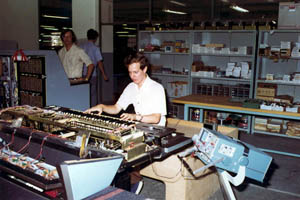 Les Deutsch at the Yamaha Engineering Model Organ in 1972
Les Deutsch at the Yamaha Engineering Model Organ in 1972 |
Yamaha loaned us a couple of musical instruments and we spent some time each night practicing in our hotel room. This must have really bothered the other guests, though we never heard a complaint. My father was a real good customer of the hotel. I was teaching myself to play the clarinet and my father was learning the French horn. Later, when my father’s contract was nearing completion, Yamaha either gave us (as my father told me at the time) or sold us these instruments.
In the year my father had been working in Japan, he picked up many Japanese customs. Not all of these were genteel. My father became quite expert at playing Pachinko. Gambling was illegal in Japan. In Pachinko, you buy a set of ball bearings and run them through the machine, trying to increase their number. You could then exchange the balls for prizes at a counter near the door. My father had noticed that big Pachinko winners invariably turned in their balls for packages of men’s black socks. This seemed odd since there were plenty of nicer prizes. He decided to follow one of these players one night. The man walked down a nearby dark alley and found a small shop that purchased his socks for cash! After that time, my father earned a small extra income playing pachinko. |
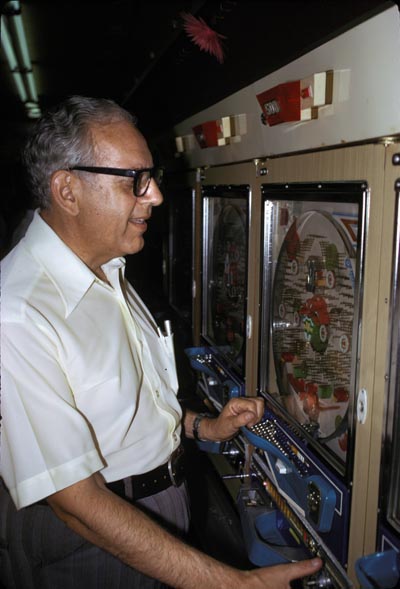
Ralph Deutsch playing pachinko in Hamamatsu
|
My father purchased a used Pachinko machine and I helped him build a frame for it. It sat in our recreation room. He would practice before each of his trips. On this trip, with me in tow, he decided to bring home Pachinko balls rather than extra cash. We would use these for our home machine. After one successful session, some Japanese men invited us to join them for a drink in a local bar. Both my father and I spoke a little Japanese, so this was a good experience to practice. I recall having to explain, in Japanese, that we were taking this huge bag of ball bearings home for our personal machine.
When we left Japan to return to Los Angeles, our bags were inspected at the airport. The agents found I had a huge bag of ball bearings in my suitcase. Luckily, they let me pass!
DRL had real offices in Encino, for the times when my father was actually in town. We had a small office suite in a building on Ventura Boulevard – very close to my grandparent’s apartment. We had a new employee, Glen Griffith, who did the detailed digital design work. I had my own office. |
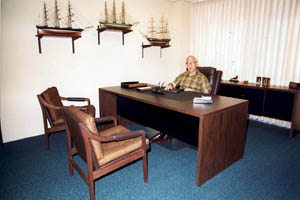
Ralph Deutsch at his DRL Office in Encino in 1973 |
My mother had an office too – but it was the receptionist’s desk by the door. I always felt this was a bit degrading.
We had an extremely advanced office for its day. We had a computer lab – and one of the very first personal computers. It was a Hewlett Packard 9830 system. Though it was based on the same chips as their line of programmable calculators, this model sported an alphanumeric display, a line-printer, cassette drives for data storage, and (in our case) a pen plotter. |
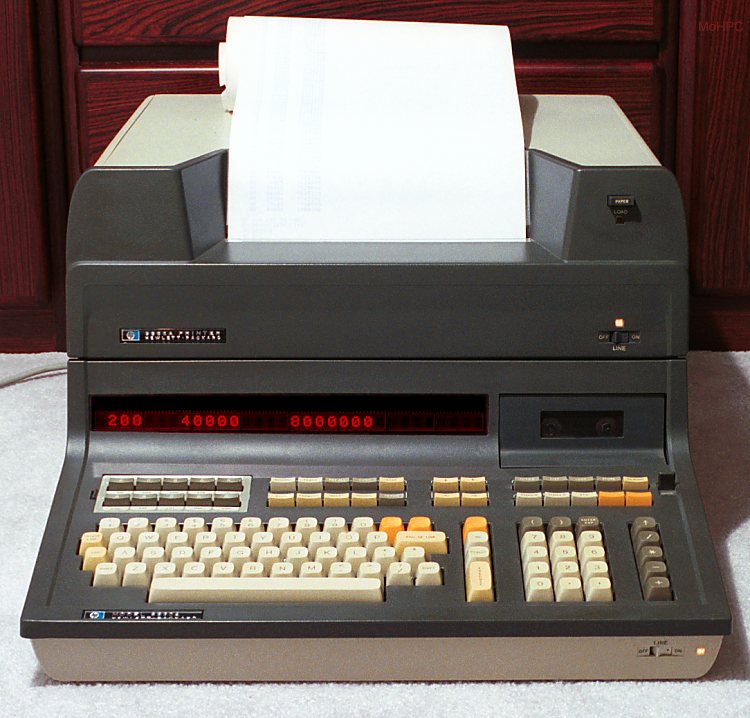
The Hewlett Packard HP 9830 with printer
|
Despite having this excellent machine, my father required me to perform a Fourier transform using only the HP35 calculator. He explained that he had to do his first one with only a slide rule – so I needed a similar experience. After I did this successfully, he let me program the 9830. One of the projects he had me write was a music publishing program that created high quality sheet music on the pen plotter. This must have been one of the very first such programs – but it took several hours per page to plot!
My father began playing in the Caltech band with me. He played cornet for a long time and eventually switched to French horn.
I have also been the organist at Caltech since my sophomore year. It is, in fact, the longest position I have ever held. Since Caltech does not own a suitable organ, we rent one each year for our commencement ceremony. We always rented Rodgers organs. We use brass and percussion with the organ and I have, for the most part, also arranged the selections. My father played in this group from the start and only retired from it about ten years ago.
Although the Yamaha engineering model organ was a success, Yamaha decided to proceed instead with its FM synthesizer scheme. |
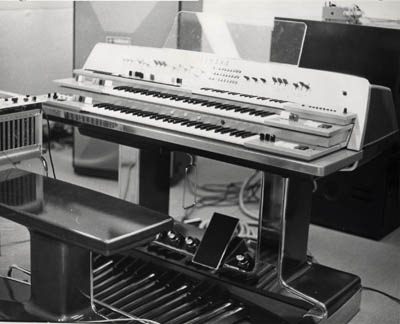 The completed Yamaha Engineering Model Digital Organ
The completed Yamaha Engineering Model Digital Organ |
By 1975 my father had left Yamaha. The Grand Hotel in Hamamatsu, where my father had spent about half of his time in the last several years, threw him a going away party. It was held in the Japanese steakhouse and my father’s favorite cook, Sato, prepared the food. They brought in ice cream from the main hotel for desert – but forgot to bring spoons. Those assembled had to eat their ice cream with chopsticks.
The short period when DRL had no contract was extremely stressful on my family. It was probably the longest period my father had gone without an income.
Since my father got tired of having to work with a patent attorney each time he needed to file patent, he used this newfound free time to study patent law on his own, using two books he purchased at a legal bookstore downtown. He then sat for, and passed the Patent Bar. He became a licensed patent agent and began doing all his own patent work. He also prepared all the drawings – with his Leroy Lettering Set! My mother did a lot of the typing.
Luckily, he signed a contract with Kawai later that year. Since Kawai was also located in Hamamatsu, my father resumed residency at the Grand Hotel.
When I received my B.S. degree in 1976, there was no Rodgers organ available to rent. My father provided our own home Rodgers 32B organ for the ceremony. Caltech paid for its move back and forth. |
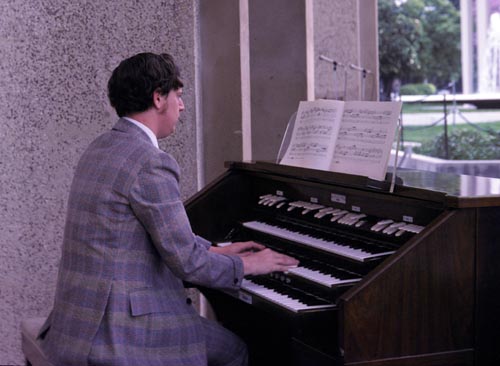
Les Deutsch playing the Rodgers 32B at Caltech in 1976 |
My father also played with me on the fourth of July each year in the San Marino Dad’s Band. This was an amateur group of local musicians who assembled to play concert band material and patriotic marches. My father played the cornet in this group and I usually played the piccolo.
At some point, my father switched completely to playing the French horn. He formed a horn quartet with one of his friends from the Caltech band who also worked in the USC music library. The four players met each Saturday morning at our house. My father called the group the “Moose Callers”. In 1979, my father asked me to compose some music for the group. I wrote “Introduction and Rondo” for them.
By this time, DRL gave up the Ventura Blvd offices and our one hired engineer. My father, my mother, and I were now the only employees. My father’s den was now the main office. We had a new computer, a Tektronix 4051. The computer was based on the successful line of Tektronix graphics terminals. It was much faster than the old HP 9830, but much slower than anything that exists today. |
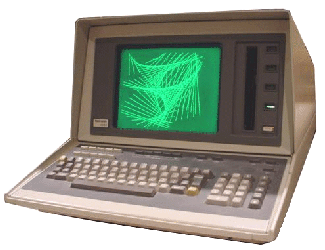
The Tektronix 4051 computer |
I had applied to only a few places for graduate school and was accepted everywhere. I had to decide between Caltech and MIT. I remember telling my father that if I went to MIT I would live with his brother George. In the end, I chose Caltech and stayed at home once again.
I was dating Karen very seriously by the late 1970s. I remember talking to my parents about getting married. They discouraged me and made me promise to wait until after I received my Ph.D.
Kawai provided our family with tickets to attend the North American Music Merchants (NAMM) trade show each winter in Anaheim. Our first NAMM Show was in 1976. It was held at the Disneyland Hotel. The following year it moved the Anaheim Convention Center, where it has stayed ever since except for the three years the center was being renovated. I look forward to this show every year. It is the best way to follow all the new things going on in the music industry. My current tickets come from our local Rodgers dealer.
It was through the NAMM community that my father became reacquainted with his first cousin, Herbert (Herb) Deutsch. They were quite close in childhood and then lost touch with each other. By an extraordinary coincidence, they both ended up making major contributions to electronic music. Cousin Herb became an accomplished musician and composer, specializing in contemporary classical music. At some point, he met a man named Robert (Bob) Moog. Moog had been building Theremins, instruments that are played by moving your hand in the proximity of a pair of antennas. Theremins were popularly used in the sound tracks of old science fiction movies. They were named for their inventor, Leon Theremin, who was a Russian electronics genius and who later built spy systems for the KGB. Herb convinced Bob to attach a keyboard to his electronics, creating the first synthesizer. Herb and Bob continued to work together, developing and popularizing the synthesizer.
In addition to Herb, my father often talked of another cousin who played oboe in the Boston Symphony. This was evidently Ira Deutsch. I never met him.
We finally got rid of the big model railroad in the recreation room. It was donated to a center for troubled youth. My father bought a pool table to go in its place. He had always wanted a pool table. He did the research and selected a top quality professional size table. He also purchased some very nice pool cues. With a little practice, my father was quite good at pool. He could beat any of us easily.
I was now a mathematician with a B.S. and studying for my Ph.D. at Caltech. My father decided I was now old enough to join him in his inventions. The basic patents for the Kawai organ are held jointly between my father and I as co-inventors.
The Kawai organ program was very successful and it was a happy time for my father. The Kawai Engineering Model, which was called the “KEM” was demonstrated to Kawai management in 1978 and the company decided to move toward production. Work was started on two prototype systems, a spinet and a console organ. Kawai even used my father’s suggested trade name for the new system: ADEPT, for “Advanced Digital Electronic Polyphonic Tone.” |
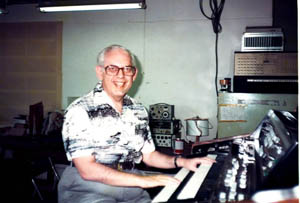 Ralph Deutsch at the Kawai Engineering Model (KEM) in 1978
Ralph Deutsch at the Kawai Engineering Model (KEM) in 1978 |
| My parents liked Karen. When they planned a big family vacation in 1979 in Hawaii, they included Karen, though she was only my fiancé at the time. My mother, sister, Karen, and I flew to Hawaii and then met my father who was coming from Japan. I recall that I was getting ready to buy my first tuba. I had all the Yamaha catalogs with me. My father could not understand why I wanted a tuba – but it was my own money. He arranged for me to buy it at the factory price. My other vivid memory from that trip was that we ran into my high school band director, Syd Lasaine, and his wife at the Polynesian Cultural Center and had lunch with them. |
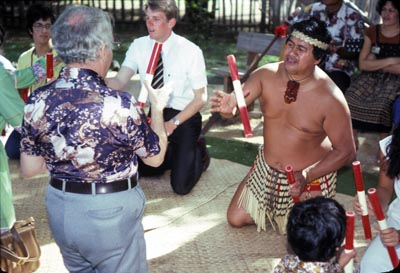
Ralph Deutsch having fun at the Polynesian Cultural Center |
I received my Ph.D. in mathematics in 1980, and so it was time to marry Karen. My parents were entirely in favor of this now. I had achieved the Ph.D. and now they could have grandchildren.
In 1979, my father and I attended an open house at Caltech’s Jet Propulsion Laboratory. For my father, this was a visit back to his career in aerospace. I let him select the labs we visited. We ended up in optical communications and atomic clock laboratories. I did not know then that within a year I would be working in this very Section at JPL and within six years I would be managing the Section. My father had an odd knack for these sorts of things.
I had planned to pursue a career as a mathematics professor, but I solved my dissertation problem too late in the academic year to find a good college position for the following year. One of my professors at Caltech suggested I take a job at JPL for a while and apply for college positions again the following year. I interviewed at JPL in June 1980. I already had more than a half dozen patents – due to working with my father – and this certainly helped. I got three different job offers from JPL and had to select between them. I chose the area that my father and I had visited at the recent open house.
My father had promised that he would buy me a car for graduation. Karen and I shopped around and decided on a Volvo station wagon. My father partially reneged on his promise. He claimed he had not promised he would buy an expensive foreign car. He paid for a potion of it equal to the cost of an equivalent Ford station wagon.
Karen and I found an apartment in Glendale. I moved in a few days before our wedding, but I stayed at my parent’s house the night before. In the three days I was gone from their house, my father had converted my bedroom into a computer lab! Since Karen’s family was rather poor, Karen and I paid for our own wedding. My parents sponsored the bar at the reception. We had an eight-piece band at our reception, made up mostly of friends. Both my father and I played with the band a bit. In addition, we had arranged for Manny Klein to play trumpet with the band. Manny was easily one of the best and most recorded trumpeters of the 20th century. I first learned about him from hearing him on records my father used to play – including those of Jewish comedian Mickey Katz. Manny actually led Katz’s band. Bill Bing, the band director at Caltech and a longtime friend told me he could get Manny to play at our wedding and all I had to do was buy him a couple of good cigars! To this day, it is the only time I have ever been in a cigar store. My father and Manny actually played together on a couple of songs and this was a highpoint of the party. |
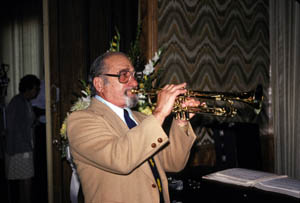
Manny Klein playing the trumpet at Les and Karen’s wedding reception
|
| After the reception, Karen and I stopped at my parent’s house to pick up our luggage for our honeymoon in Lake Tahoe. As we were getting back into my car, my parents threw a bucket of uncooked rice into the car. My father explained that he had to deal with this at his own wedding so we had to do so now! |
|
|

